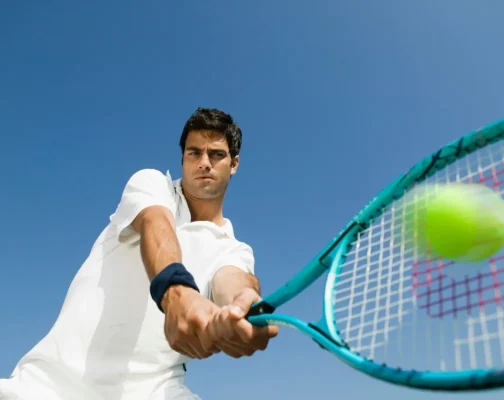Why good vision is critical in tennis: how to train an athlete’s eyes
Tennis is a sport that demands lightning-fast reflexes, split-second decision-making, and exceptional hand-eye coordination. But at the foundation of these skills lies a fundamental physical ability often overlooked: vision. Without sharp, dynamic vision, even the most technically proficient player will struggle to maintain a competitive edge. In this article, we explore why good eyesight is critical in tennis and how athletes can train their visual system for optimal on-court performance.
The importance of vision in elite tennis performance
Vision is more than just the ability to see clearly. In tennis, it involves several interrelated abilities:
- Visual acuity: The clarity or sharpness of vision, especially important when tracking the ball across the court.
- Depth perception: Understanding how far away the ball is, critical for timing shots.
- Peripheral awareness: Detecting the opponent’s movement outside the central field of view.
- Eye-tracking: Following the ball’s path seamlessly during fast rallies.
- Contrast sensitivity: Differentiating the ball from the background and surroundings.
These elements come together to influence a player’s reaction time, decision-making, and shot accuracy.
Common vision challenges in tennis
Even small deficits in visual function can significantly impact a tennis player’s performance:
- Late reactions to serves or volleys due to poor depth perception.
- Inaccurate judgment of ball speed and trajectory.
- Fatigue-induced eye strain, leading to decreased focus in long matches.
- Overreliance on central vision, ignoring peripheral cues like the opponent’s position.
Recognizing and addressing these visual issues can be the difference between winning and losing in high-stakes matches.
How to assess vision in tennis players
Before implementing training, it’s essential to assess the athlete’s visual capabilities. Sports vision specialists use tools like:
- Eye charts for visual acuity.
- Brock string exercises for depth perception.
- Saccadic movement tests for tracking and eye coordination.
- Reaction time software paired with motion capture.
Professional assessments help tailor vision training programs to the individual needs of each player.
Methods to train and improve vision for tennis
Dynamic visual acuity drills
These exercises focus on improving clarity of vision while in motion. Examples include:
- Tracking letters or numbers on rotating wheels.
- Reading while on a balance board to mimic match movement.
Depth perception training
Improving spatial judgment enhances timing. Techniques include:
- Using stereoscopic images to judge relative distances.
- Ball toss and catch drills with varying distances.
Peripheral awareness enhancement
Expanding the player’s field of view helps in anticipating opponents’ movements:
- Light board drills (e.g., FitLight or Dynavision).
- Multi-object tracking games where focus must shift rapidly.
Eye-hand coordination and reaction speed
Improved visual-motor response allows players to react quicker:
- Ball drop reactions: Catching randomly dropped balls from a partner.
- Quick-response targets: Hitting illuminated spots on a reaction wall.
Integrating vision training into tennis practice
Tennis-specific visual drills can be seamlessly included in regular training sessions. Coaches and performance staff can:
- Use color-coded tennis balls to work on focus and identification.
- Add visual cues (e.g., hand signals) during footwork drills.
- Simulate match scenarios with varied lighting to build contrast sensitivity.
Vision training doesn’t require isolated sessions but can be woven into warm-ups, skill work, and even recovery routines.
How vision affects different phases of play
| Phase of Play | Visual Skills Involved | Impact on Performance |
|---|---|---|
| Serve | Depth perception, focus | Accurate targeting and power adjustment |
| Return | Eye tracking, reaction speed | Fast anticipation and control |
| Rally | Peripheral vision, dynamic acuity | Consistent timing and shot placement |
| Net Play | Spatial awareness, focus switching | Effective volleys and smashes |
| Defensive Recovery | Peripheral awareness, quick refocusing | Better positioning and counter-attacks |
Understanding how vision works in each context helps players and coaches prioritize the right type of visual training.
Vision training tools and technologies
Modern sports science offers various tools to improve tennis vision:
- Strobe glasses: Temporarily block visual input to sharpen focus and prediction.
- Digital reaction trainers: Simulate game-speed decisions using screens or lights.
- Virtual reality (VR) systems: Create immersive training environments to improve depth perception and eye tracking.
These tools can be combined with cognitive drills to simultaneously train the brain and eyes.
The psychological link: vision and confidence
Visual sharpness is closely tied to confidence on the court. When players trust what they see, they commit more fully to their shots and strategies. Poor vision or visual inconsistency often leads to hesitation, missed timing, and self-doubt.
Integrating vision exercises into mental skills training can enhance both visual performance and match-day mindset.
When to start vision training
Ideally, vision training should begin during youth development stages and continue throughout a player’s career. Like muscle strength or stroke technique, vision must be maintained and adapted as players age or face new challenges.
Early exposure builds better neural pathways for visual processing, setting athletes up for long-term success.
Conclusion: Vision as the hidden asset in tennis
While physical fitness and technical skill remain the cornerstones of tennis success, vision is the silent contributor that amplifies both. Enhancing visual performance through targeted training can elevate reaction time, focus, accuracy, and court awareness.
Every elite player should consider vision training not as an optional extra, but as a key pillar of their athletic development.

